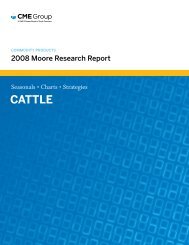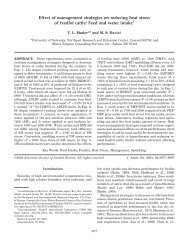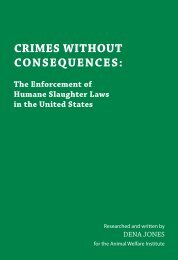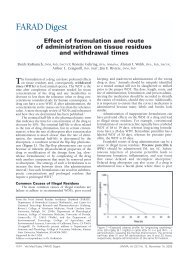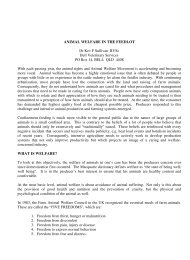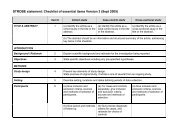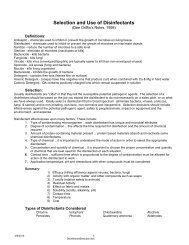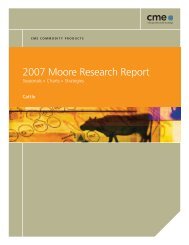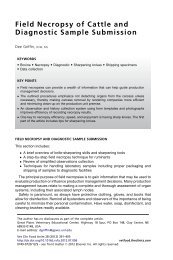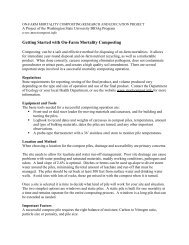Drylot Beef Cow/Calf Production AS-974 PDF
Drylot Beef Cow/Calf Production AS-974 PDF
Drylot Beef Cow/Calf Production AS-974 PDF
Create successful ePaper yourself
Turn your PDF publications into a flip-book with our unique Google optimized e-Paper software.
10<br />
Facilities and Equipment<br />
Site Selection<br />
The site chosen for a cow/calf drylot facility should<br />
be well-drained with appropriate pollution controls to<br />
avoid contaminating watersheds. Wintering quarters<br />
for gestating cows may need to be upgraded to<br />
control runoff. Check with state and county offi cials<br />
to determine permitting requirements. Site selection<br />
should be based on water availability, roads, slope<br />
of the land and soil type, proximity to neighbors,<br />
drainage, wind direction and odor. These are physical<br />
and operational criteria that can affect quality of<br />
life and relationships in the neighborhood. The<br />
reader is referred to the “Midwest Plan Service <strong>Beef</strong><br />
Housing and Equipment Handbook” (fourth edition,<br />
1987) available from your county Extension offi ce<br />
for facilities recommendations and critical design<br />
dimensions.<br />
Number of Pens<br />
Separate pens are suggested for (1) fi rst-calf<br />
heifers and old or thin cows, (2) the main cow herd<br />
with multiple pens if numbers require, (3) growing<br />
replacement heifer calves and (4) bulls, possibly two<br />
pens for young and old bulls. Large numbers of pairs<br />
in one pen make sorting for artifi cial insemination<br />
(AI) or health care diffi cult. Excessive crowding from<br />
severe weather, wild animals or other circumstances<br />
can result in injury or death to small calves. Sixty to<br />
80 pairs per pen is the recommended maximum, but<br />
this will vary with space allotment and pen design.<br />
Pen Design<br />
Pen size and lot space per cow/calf pair are quite<br />
variable, depending on the drainage and soil type.<br />
A general recommendation is for a minimum of 500<br />
square feet per pair, with 800 to 1,000 square feet<br />
desirable, especially with less than optimum drainage.<br />
Larger lots tend to allow more blowing dirt, a potential<br />
cause of pneumonia for baby calves. Partially paved<br />
areas may be useful around waterers and bunk lines,<br />
and for relatively fl at lots. Smaller paved areas (300 to<br />
500 square feet per pair) increase crowding but may<br />
reduce fl y problems and muddy cows, especially if<br />
paved areas are scraped often.<br />
Fencing<br />
Fencing for the drylot should be sturdy, lowmaintenance<br />
and able to withstand the stress of<br />
mature cows crowding and reaching. Used railroad<br />
ties, treated posts and steel pipe are long-lasting<br />
and low-maintenance. Steel cables or metal rod,<br />
such as well stem, sucker rod or pipe, are excellent<br />
for fencing. Mesh panels and lumber fences require<br />
more maintenance and will need replacement at<br />
much shorter intervals. Panels tend to get pushed<br />
out of shape in high-stress areas. Full-dimension<br />
rough lumber is preferred over smooth boards but<br />
often is warped and full of knots. High-tensile electric<br />
fence or barbed wire can be used successfully but<br />
requires frequent tightening. High-tensile fence is<br />
subject to penetration from crowding or frightened<br />
animals, requiring time-consuming sorting of animals.<br />
If animals put pressure on a fence, running an electric<br />
wire along the inside or the top of the fence may<br />
be necessary. Fences should be a minimum of 60<br />
inches tall, especially if larger cows or animals of<br />
questionable disposition are involved.<br />
Shade<br />
If shade is constructed, 40 square feet per cow/calf<br />
is recommended. <strong>Cow</strong>s made very limited use of<br />
the pole-framed corn-cribbing shade available at<br />
the Carrington Research Extension Center. Dualpurpose,<br />
shade/windbreak-designed, self-supporting<br />
structures may be useful equipment for beef cows in<br />
the northern Plains.<br />
Feed Bunks<br />
A variety of feed bunks works for cows. Mixed rations<br />
can be fed in fence line feed bunks or feeding fences<br />
designed without bunks. Feeding in bunks within<br />
pens is possible but mud and gate management<br />
can be problems. Feeders that can be placed inside<br />
pens include turned tractor tires, commercial metal or<br />
wood bunks, salvaged wide conveyor belting pulled<br />
up to a “u” shape or other containers. Round bale<br />
feeders or forage racks on a trailer chassis are useful




